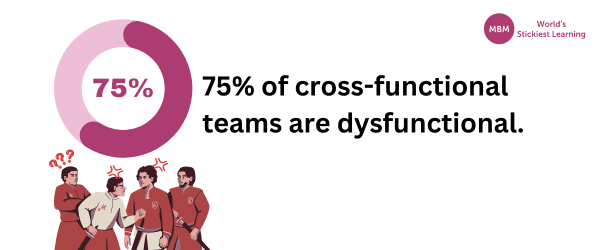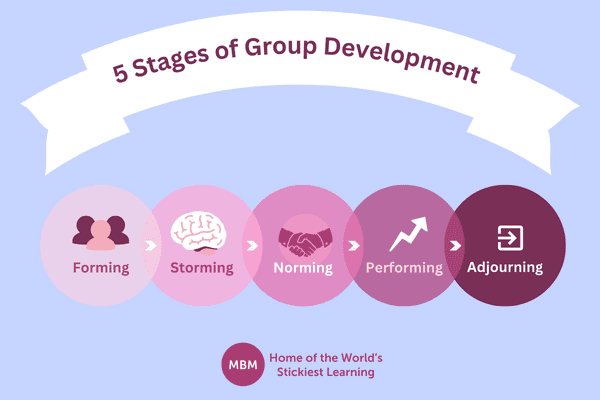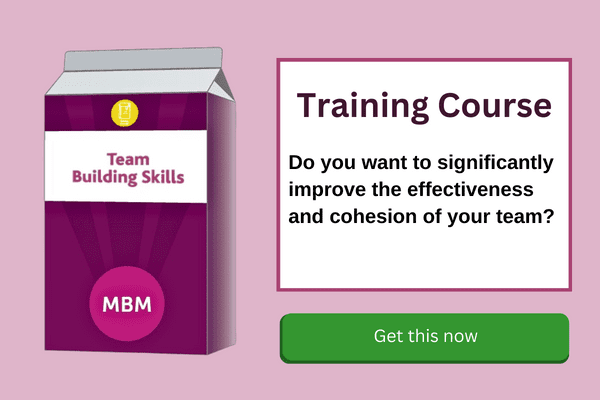Putting Team Psychology to Work
Team cohesion isn’t just a luxury—it’s a necessity for success. According to a study by the Harvard Business Review, 75% of cross-functional teams are dysfunctional, failing to meet their objectives due to communication breakdowns and interpersonal conflicts. Tuckman’s Model describes the different stages in work teams’ development.

Leaders and managers can use this model to help their people be the “best version of themselves” throughout the journey. Understanding Tuckman’s Model is more than just a theoretical exercise—it’s a roadmap to unlocking the full potential of your team. From forming to adjourning, each stage presents unique challenges and opportunities for growth.
In this article, we delve into Tuckman’s different stages, offering practical insights and strategies for navigating every phase of team development. And we have some helpful takeout tips and team-building activities for each stage. So whether you’re leading a project team or managing a long-standing group, mastering Tuckman’s Model is the key to fostering collaboration, productivity, and success.
Forming, Storming, Norming, Performing, Adjourning. It’s Catchy. But It’s Also Critical

Psychologist Bruce Tuckman created his Model in 1965, to describe the process in which colleagues come together in teams. Initially, he identified four stages:
- Forming
- Storming
- Norming
- Performing
And in 1977, Tuckman added a fifth stage:
- Adjourning
It takes a while for team members to get used to each other’s personalities and ways of working. As this happens, they bond and grow in understanding. At all stages in Tuckman’s model, leading and managing a team needs self-awareness and emotional intelligence. It’s about understanding people’s feelings, as well as focusing them on the task.
Note that empathy and compassion for your team are central aspects of servant leadership. Interestingly, this concept has gained new prominence since the death of the Queen, who set a great example. As proof, businesses of all kinds are paying more attention these days to their staff’s mental health and wellbeing. Whatever your leadership style, Tuckman’s Model helps you empathise with your team, and support them.

What’s in a Name? Lots, Actually!
Dr. Bruce Tuckman introduced his Model in the mid-1960s. During this era of innovation and transformation, spanning from space exploration to pop culture. Additionally, psychologists were swept up in the zeitgeist alongside everyone else. Reflecting the spirit of the age, Tuckman bestowed the stages with names that remain catchy even today. Moreover, as we’ll learn, the titles he devised are remarkably apt.
The Different Stages in Tuckman’s Model
Tuckman saw the stages in his Model starting when a group first forms and continuing until it ends. Let’s see what happens in each stage, and what you should focus on.
Stage #1: Forming

During the forming stage, team members are like strangers thrown together in a new environment. You’ve introduced the team members and assigned tasks. At this point, members haven’t bonded yet, so they tend to think independently, not as a team. Each member brings their unique background, skills, and expectations to the table. However, without established rapport or shared goals, there may be hesitancy and uncertainty among team members.
For instance, individuals may be cautious about expressing their opinions or hesitant to take on specific roles without a clear understanding of their teammates’ capabilities. In this stage, the challenge lies in building trust and establishing a sense of unity among diverse individuals who are just beginning to acquaint themselves with one another.
What to Focus on in Stage #1
- What role each person will play?
- Different people’s skills, backgrounds and interests: Be aware of the diversity in the team, and the positive contribution this can make, bringing fresh ideas. Be sure to welcome different thinking. This will prevent you from having to use your conflict resolution skills.
- Your goals: Get people to commit to a team charter.
- The team plan and timeline: Be prepared to flex, pivot and be resilient about modifying the project.
- Finally, rules, regulations, and expectations: Now all this should be set out in the team charter. Understanding Vroom’s Expectancy Theory – you’re rewarded when you deliver what’s expected of you – will help engage and motivate people.
Activities to Try
Conducting icebreakers and doing some bonding. Follow these 7 steps to being a great team leader:
- You’re still the leader, but learn from your people and be humble.
- Create a vision for your team.
- Have frequent meetings to talk about this stuff.
- Give constructive feedback.
- Set an example.
- Support your team.
- Build relationships with your team members.
Stage #2: Storming
Here, the honeymoon’s over and the novelty’s worn off. Consequently, as the initial excitement wanes, the team faces turbulent waters. Picture a group of passionate individuals, each with strong opinions and approaches, coming together to tackle a project. However, disagreements over priorities, strategies, or responsibilities may emerge, leading to clashes in viewpoints and tensions among team members.
Consequently, managing egos and emotions becomes crucial as the team navigates through this challenging phase, striving to find common ground and resolve conflicts constructively. It’s akin to the “Terrible Twos” of team development, necessitating patience, diplomacy, and effective communication to steer the team towards productive collaboration.

What to Focus on in Stage #2
- Inspirational leadership: Show gratitude to team members for their efforts and clear guidance.
- Encourage team members to be self-aware about how they come across, and not put others off contributing.
- Encourage critical thinking, self-evaluation and active listening.
- Conflict resolution: Work on reaching a consensus on how best to complete tasks or improve performance. Involve as many people as possible in evaluation and decision-making.
Activities to Try
Exercises that focus on negotiation skills, conflict resolution, communication, problem-solving and trust building.
How to Spot When You’re “Stuck” in the Storming Stage

Watch for these behaviours:
- Increased frustration.
- More complaints.
- Less productivity.
- Disengagement from work.
- Interpersonal conflict between members.
- Lack of respect towards management and leadership.
Keep These Storming Stage Strategies in Mind
Gratitude, compassion, listening and a positive attitude should see you through. Here are some storming stage strategies to work on:
- Focus on building trust.
- Get to know your team members. And also get them to know each other.
- Continually work on better collaboration.
- Build a team culture of honesty and also transparency.
Stage #3: Norming
As the team progresses, they start to find their rhythm and work harmoniously towards their shared objectives in Tuckman’s model stage. Picture a group of individuals who have overcome initial conflicts and now work together seamlessly. However, new stresses may surface, particularly in project teams, where members have other responsibilities.
Despite this, the team focuses on maintaining effective communication, supporting each other, and adapting to evolving tasks with resilience. In this stage of norming, the team focuses on maintaining effective communication, supporting each other’s well-being, and also adapting to evolving tasks and challenges with resilience and flexibility.
What to Focus on in Stage #3
- Seeking opportunities for developing people. Look out for individuals showing leadership and also other particular abilities. Encourage them.
- 2-way communication: Giving feedback in the moment, or ASAP afterwards. Don’t wait until the next team meeting!
- Helping team members maintain their window of tolerance and stay calm as new tasks appear and changes need to be made.
- Supporting people’s wellbeing and resilience: Some companies have mental health first aiders trained to support staff members.
- Relationship building: In businesses, projects can be a “side hustle.” As we said, team members may have full-time roles, and have to give time to those. Encourage people to make allowances.
Activities to Try
Exercises that focus on improving planning skills, adaptability and managing change.
Stage #4: Performing

Here, you’re flying! Team members understand each other’s strengths and weaknesses in this stage and know each other well. Each member is confident and motivated and also can operate without strict supervision. This is the Tuckman’s model stage when you get your best work done.
What to Focus on in Stage #4
- Encouraging creativity and rewarding innovation.
- Boosting team morale: Do this with effective communication, consistent employee treatment and mental health and wellbeing support.
- Encouraging confidence and motivation: Appreciate what makes each person tick. Also, understand Vroom’s Expectancy Theory.
- Supporting autonomy: Encourage initiative, and delegate as much as possible. Remember, you still have overall control.
- Reducing “oversight”: In the same vein, encourage independent working and also don’t micromanage!
Activities to Try
Exercises that help your teams stay cooperative, engaged and also motivated.
Stage #5: Adjourning
This part of Tuckman’s model primarily applies to projects, as we’ve said, but it applies as well to other work, as we’ll see. When a project is completed, the team disbands. It’s only natural for team members to feel a sense of mourning, even loss if they’ve become close. Meanwhile, for leaders and managers, completing the project successfully brings some specific benefits, which you should think about. And you should ALL enjoy the moment!
What to Focus on in Stage #5:
- The learnings from the project: What do you and the team think these are?
- The positive shared experience for team members: The team feeds back and considers how to apply this in other areas.
- Developing and retaining the talent pool: Keep records of who’s worked on what, to help you staff up for other projects. Update the database as people gain experience in skills and leadership.
- CELEBRATING the team’s achievement.
Activities to Try
You can help individuals overcome their resistance to change with some exercises from the world of therapy. A popular one involves bouncing a ball and asking them how they felt when it hit the ground. Did they worry it wouldn’t bounce up again? In another exercise, the facilitator asks participants to sit in a circle and look at an object in the centre. They ask them to change seats and look again and ask if they notice any differences.
And finally, in the adjourning stage, the team want to celebrate achievements and success. You’ve done the hard work and you’ve completed the project. And now, says Tuckman’s Model, celebrations are the order of the day. So, party on – you deserve it!
Why are the 5 Stages of Group Development Important?

Understanding how all this works is important because it enables you to:
- Get teams started.
- Resolve conflicts more smoothly.
- Share information effectively.
- Achieve goals and results.
- Review outcomes and keep finding ways to improve.
How Can You Use Tuckman’s Model Effectively?
Here are some instances where it comes in useful:
- Training new teams for projects, post restructures or following business growth: Sharing the model can help team members understand that their feelings and frustrations are perfectly normal as teams develop.
- Ongoing coaching: Referring to the model in coaching sessions can help individual team members understand their behaviour’s impact. It can also help them see why they, or others, are behaving as they are.
- Supervisor training: Newly appointed managers may find it helpful to refer to the model in their early days.
- Leadership training: Linking Tuckman’s model with considering the different leadership styles and their impacts will help in management coaching sessions.
Tuckman’s Model Applies Most of All to Projects…
It’s easiest of all to see how Tuckman’s model works in project teams. They go through the classic stages of forming, storming, norming, performing, and adjourning when the project ends. You can apply Tuckman’s model to many kinds of business activity of finite duration. Examples include:
- Business improvements and relocation.
- Company restructuring.
- Digitisation.
- Engineering projects.
- Flotations.
- Marketing campaigns.
- Mergers and acquisitions.
- NPD and product launches.
- Sustainability programmes.
- Test markets.
But Tuckman’s Model Also Explains What’s Happening in “Permanent” Work Teams

Work teams change as people come and go, and much the same psychological processes happen. When someone joins a company, they join a team that’s already formed. The newbie goes through a Forming, Storming, Norming and Performing cycle. And the rest of the team adjusts to them. That takes time.
If a team member doesn’t reach the performing stage satisfactorily, they will also be moved into the Adjourning phase! And then there’s the situation involving someone who has been a major part of a team. That moves the team into an adjourning phase too. Either way, the old team has gone, and the cycle restarts.
You can also use Tuckman to understand what’s happening to customer relationships and client relationships as front-line people change. Like our newbie joining the company, account handlers of whatever seniority must bond quickly with their opposite numbers. So, the Forming, Storming, Norming and Performing cycle also happens at an accelerated pace.
Diversifying into New Business Areas – Is it a Project, Or a Permanent Move?
It’s relevant to ponder this because as a leader or manager, you’re concerned for your team’s wellbeing and performance. In consumer-facing businesses, diversifications and product launches are often seen as being of finite duration. This has as much to do with the budget allocation as anything else. But if the diversification or product launch succeeds fantastically, in time it will become a permanent operation. And then things will change again. Meanwhile knowing Tuckman’s Model will help you support the team’s development.
Conclusion
In conclusion, Tuckman’s Model offers valuable insights for navigating the complexities of team dynamics. From forming to adjourning, each stage presents unique challenges and opportunities for growth. Consequently, by understanding and applying this framework, leaders and managers can foster collaboration, resolve conflicts, and drive success in diverse team settings. Therefore, I encourage readers to reflect on their team dynamics and consider implementing strategies informed by Tuckman’s insights to unlock their team’s full potential.
Action: For even more useful content on team building, check out our ultimate guide on Team Building Skills.
Updated on: March 25, 2024




